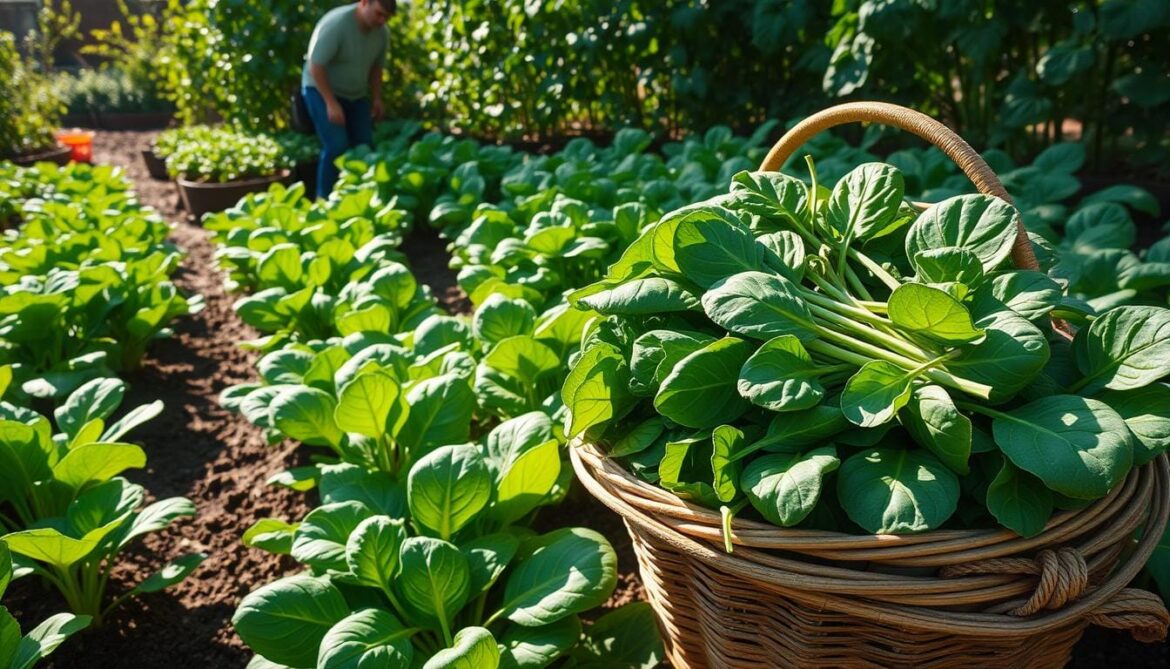Growing spinach is a tradition in our family. Every spring and fall, we nurture our garden. We watch the leaves grow from tiny seedlings to strong, healthy plants. Knowing when to pick spinach can make a big difference.
Our guide is for both new and seasoned gardeners. Spinach loves cool weather and takes about 6 weeks to grow. Paying attention to timing is essential to get the best leaves.
We’ll show you how to pick spinach at the perfect time. This way, you can enjoy the tastiest greens from your garden. Whether you want baby spinach or full-grown leaves, we’ve got you covered.
Key Takeaways
- Spinach grows best in temperatures between 35-75°F
- Harvest can begin when plants reach 4-6 inches tall
- Cool weather seasons (spring and fall) are ideal for spinach
- You can harvest up to 1/3 of plant leaves without damaging growth
- Proper timing prevents bolting and maintains leaf quality
Understanding Spinach Growth Stages
Growing spinach needs careful attention to its growth stages. Our guide will help you understand these stages and know when spinach is ready to harvest.
Spinach is a cool-season crop with unique growth traits. From seed to harvest, it goes through several key stages. Gardeners must watch these stages closely.
Seed Germination Process
Spinach seeds are very sensitive to temperature and soil. They need the right conditions to sprout:
- Ideal germination temperature: 40°F-70°F
- Seed planting depth: 1/2 inch
- Initial seed spacing: 2 inches apart
- Germination typically takes 7-14 days
Seedling Development
After germination, spinach seedlings grow fast. They develop true leaves and a strong root system. Key points include:
- Seedling stage duration: Approximately 7 days
- Recommended spacing: 4-6 inches between plants
- Water requirements: 1-1.5 inches per week
Mature Plant Characteristics
As spinach plants mature, they show clear signs. Gardeners should look for:
- Vegetative growth stage: 28-42 days
- Leaf size reaching approximately 6 inches
- Optimal harvest window before bolting occurs
“Understanding each growth stage is key for healthy, nutritious spinach,” says Dr. Emily Green.
Our insights help gardeners track their spinach’s growth. This ensures a flavorful and nutritious harvest.
Ideal Spinach Harvesting Time
Choosing the right time to harvest spinach is key. We’ll look at when to pick leaves at different stages. This ensures the best taste and nutrition.
Knowing when to harvest spinach is vital for success. Our guide will help you get the most from your spinach at every stage.
Timing for Baby Spinach
Baby spinach is young and tender. It has:
- Height: 4-6 inches tall
- Leaf size: 2-3 inches long
- Harvest window: 20-30 days after sowing
For baby spinach, harvest when leaves are as big as a U.S. quarter. This keeps them tender and flavorful.
Timing for Mature Spinach
Mature spinach has bigger leaves and a stronger taste. Here’s when to pick:
- Days to maturity: 38-50 days
- Leaf length: 3-6 inches
- Recommended harvest: Before temperature reaches 75°F
“Timing is everything when harvesting spinach – too early or too late can compromise taste and texture.”
Our strategy for spinach harvest involves watching plant growth. We recommend picking no more than 1/3 of each plant. This helps them keep growing.
| Spinach Stage | Harvest Time | Leaf Characteristics |
|---|---|---|
| Baby Spinach | 20-30 days | 2-3 inches, tender |
| Mature Spinach | 38-50 days | 3-6 inches, robust |
By knowing these harvest times, gardeners can have many spinach harvests all season long.
Signs of Readiness for Harvest
Learning about spinach leaf quality is key for gardeners. Our guide shows you how to know when your spinach is ready. This ensures you get the best leaves.
Knowing when to pick spinach is important. It should be between 40-60 days after planting. Look for certain signs to know it’s time.
Leaf Color and Texture
Mature spinach leaves show clear signs of being ready:
- Deep green color with a vibrant look
- Thick, broad leaves with a slightly crinkled feel
- Leaves that are crisp and full
Plant Height and Development
The height of your spinach plants is a clue to when to harvest. Most spinach is ready at 4-6 inches tall. You can pick outer leaves at any time.
| Growth Stage | Harvest Indicators | Recommended Action |
|---|---|---|
| Early Stage | 3-4 inches tall | Harvest baby spinach leaves |
| Mature Stage | 4-6 inches tall | Full leaf harvest |
Flowering Indicators
Bolting is a big sign in spinach growing. When plants start flowering, it’s almost time to stop picking. Warm weather, 70°F to 85°F, can make plants bolt fast, lowering leaf quality.
Pro tip: Harvest spinach early in the morning when leaves are most crisp and tender.
By watching these signs, gardeners can get the best taste, nutrition, and yield from their spinach.
Different Harvesting Methods
Understanding different spinach harvesting techniques is key to a successful crop. Our guide covers two main methods to help you grow more spinach. These techniques ensure your spinach plants thrive and produce well.
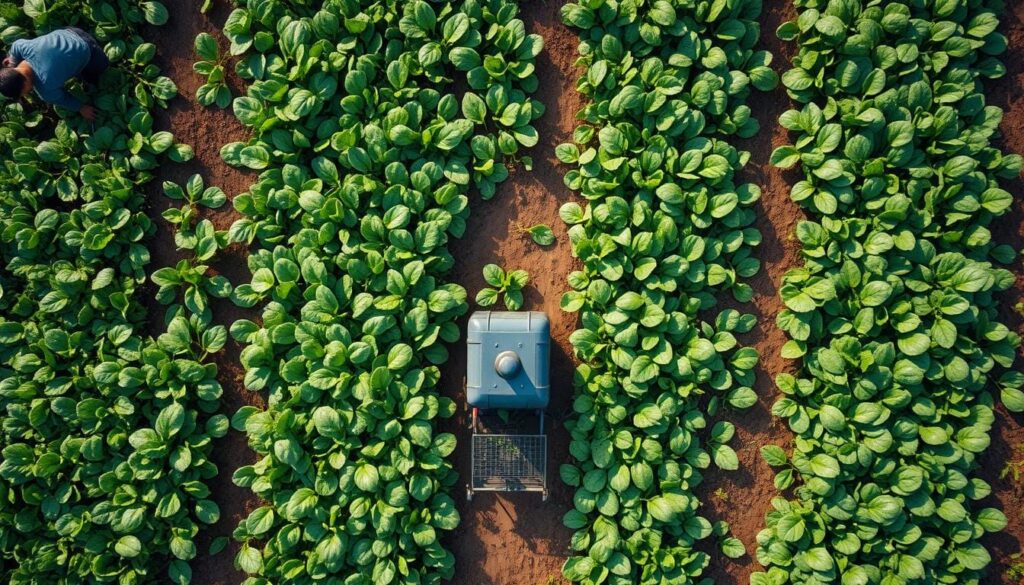
Choosing the right harvesting method is the first step to a bountiful spinach harvest. We’ll look at two main methods to help you get the most from your spinach.
Cut-and-Come-Again Technique
The cut-and-come-again method lets you harvest spinach multiple times from the same plant. Here’s how to do it:
- Harvest only 1/3 of each plant’s leaves at a time
- Use sharp scissors to cut leaves at the stem
- Leave the plant’s center intact to encourage regrowth
- Expect new leaves to emerge within 2 weeks
Pulling Entire Plants
Removing the entire plant is another way to maximize spinach yield. This method is best in certain situations:
- Ideal when plants reach 4-6 inches in height
- Recommended before temperatures rise above 75°F
- Most effective for one-time, large-volume harvests
“The key to successful spinach harvesting is understanding your plants’ growth patterns and selecting the most appropriate technique.”
| Harvesting Method | Advantages | Considerations |
|---|---|---|
| Cut-and-Come-Again | Multiple harvests | Requires careful cutting |
| Pulling Entire Plants | Large single harvest | Limits future plant production |
By learning these spinach harvesting techniques, gardeners can enjoy a steady supply of spinach all season long.
Seasonal Considerations
Growing spinach well means knowing the challenges of each season. Our guide will help you with planting and harvesting all year. Spinach does great in spring and fall, each with its own needs and obstacles.
Spring vs. Fall Harvesting Strategies
Spinach can be grown in two main seasons. Spring planting starts 4 to 8 weeks before the last frost. Fall planting is 6 to 8 weeks before the first frost. Timing is key for success.
- Spring Harvest: Best when temperatures are 50°F to 60°F
- Fall Harvest: Keeps growing into late autumn
- Spring crops usually stop by late May
Managing Frost Risks
Spinach can handle cold, even as low as 15°F (-9°C). Young plants can take temperatures from 15°F to 20°F. To protect them, use shade cloth or plastic covers for late fall or early winter.
Pro Tip: Cover young spinach plants during cold forecasts to prevent damage.
Our guide recommends planting a fall crop in early August. This way, you can enjoy fresh spinach into October or until it freezes.
Environmental Factors Impacting Harvest
Knowing how environmental conditions affect spinach growth is key to a good harvest. These factors are important from the start to the end of your spinach crop. They influence everything from germination to the final yield.
Spinach is a cool-season crop that needs specific conditions to grow well. It’s important to understand these factors to ensure a successful harvest.
Sunlight Exposure Dynamics
Spinach needs the right amount of light to grow. Here are the key sunlight points:
- Requires 4-6 hours of direct sunlight daily
- Performs best in full sun during fall and winter months
- Tolerates light shade, but only in warmer regions
Soil Quality Essentials
Good soil is the base for spinach growth. Here’s what your soil should be like:
| Soil Characteristic | Optimal Range |
|---|---|
| pH Level | 6.0 – 7.5 |
| Depth of Preparation | 6-8 inches |
| Organic Matter | Well-enriched |
Water Management
Managing water is key to prevent stress and bolting in spinach:
- Water every 2-3 days
- Keep the soil moist
- Avoid too much water
- Make sure water drains well
“Successful spinach cultivation is an art of balancing environmental conditions with careful cultivation techniques.”
By managing these factors well, gardeners can get the most from their spinach. This ensures a healthy, tasty crop that grows well under the right conditions.
Tools and Equipment for Harvesting
Getting the right tools is key to a good spinach harvest. Our guide will show you how to pick the best tools for picking spinach leaves. It will also teach you effective harvesting techniques.
Essential Harvesting Tools
Choosing the right tools can greatly improve your spinach harvest. Here are the main tools you’ll need for efficient spinach collection:
- Pruning shears for precise leaf cutting
- Sharp garden scissors
- Gardening knife
- Garden gloves for hand protection
Recommended Tool Specifications
| Tool | Best Use | Recommended Features |
|---|---|---|
| Pruning Shears | Cutting mature leaves | Sharp, stainless steel blades |
| Garden Scissors | Harvesting baby spinach | Lightweight, precise cutting |
| Garden Knife | Cutting entire plant base | Curved blade, ergonomic handle |
Tool Maintenance and Care
Keeping your tools in good shape is important. Clean tools after each use to stop disease and keep blades sharp.
“A well-maintained tool is a gardener’s best friend” – Experienced Gardener’s Wisdom
For spinach harvesting, clean tools with rubbing alcohol and store them dry. Sharpening tools regularly keeps them cutting well.
Additional Equipment Recommendations
Consider these extra items for better harvesting:
- Harvest basket for collecting leaves
- Garden trowel for seed planting
- Airtight storage containers
- Salad spinner for cleaning harvested leaves
Investing in quality tools and keeping them in good condition will make harvesting spinach better. It will also protect your garden.
Post-Harvest Care for Spinach
After harvesting your spinach, it’s important to take good care of it. This helps keep it fresh and full of nutrients. The right way to store it can make it last longer.
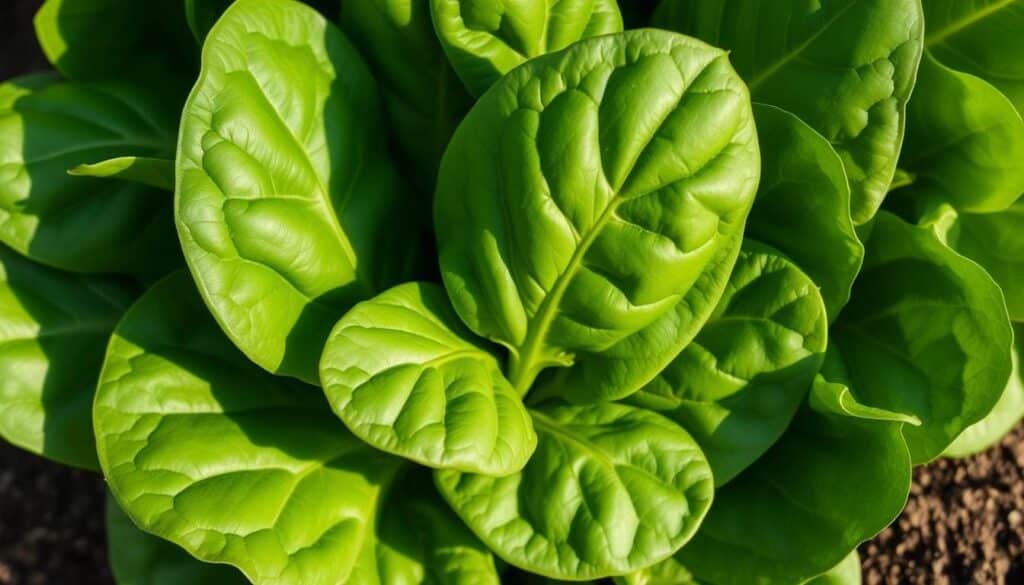
Washing and Storing Fresh Spinach
Keeping your spinach fresh is all about the right storage. Here’s how to handle your harvest:
- Store unwashed spinach to prevent moisture buildup
- Keep spinach in a loose plastic bag in the refrigerator
- Use within 1 week for optimal flavor and nutrition
- Wash only immediately before use
Preservation Techniques for Long-Term Use
If you have a lot of spinach, you can preserve it for later. Here are some ways to do it:
- Freezing:
- Blanch leaves for 30 seconds
- Quickly cool in ice water
- Pack in freezer bags
- Dehydrating:
- Use a food dehydrator
- Dry in oven at lowest temperature (2-3 hours)
- Hang in well-ventilated area
“Proper post-harvest care transforms your garden spinach from a seasonal treat to a year-round delight.” – Garden Harvest Expert
By using these storage tips, we can enjoy our spinach all year. It keeps our greens fresh and healthy.
Common Mistakes to Avoid
To get the most from your spinach, you need to watch out for common mistakes. These can hurt your plants and lower your harvest. Gardeners often make errors that affect their spinach’s growth and yield.
Risks of Overharvesting Spinach
Many gardeners take too many leaves from their spinach plants at once. This can weaken the plant and stop it from growing more. It’s important to know when and how much to harvest.
- Remove only 1/3 of mature leaves per harvest
- Leave enough foliage for plant photosynthesis
- Allow plants time to recover between harvests
Plant Health Warning Signs
Not noticing when your spinach is stressed can ruin your crop. Experienced gardeners know how to spot early warning signs.
| Warning Sign | Potential Issue | Recommended Action |
|---|---|---|
| Yellowing Leaves | Nutrient Deficiency | Adjust soil nutrients |
| Wilting | Water Stress | Modify watering schedule |
| Stunted Growth | Overcrowding | Thin plant spacing |
“Careful observation is the key to maintaining a healthy spinach garden.” – Agricultural Extension Specialist
Knowing these mistakes helps us improve our spinach growing. By watching our plants, harvesting right, and keeping the environment good, we can have a great harvest.
Nutritional Benefits of Harvesting Spinach
Spinach is a nutritional powerhouse, full of essential vitamins and minerals. We focus on spinach leaf quality indicators to get the most nutrients. Knowing the nutrient profile encourages gardeners to improve their growing and harvesting.
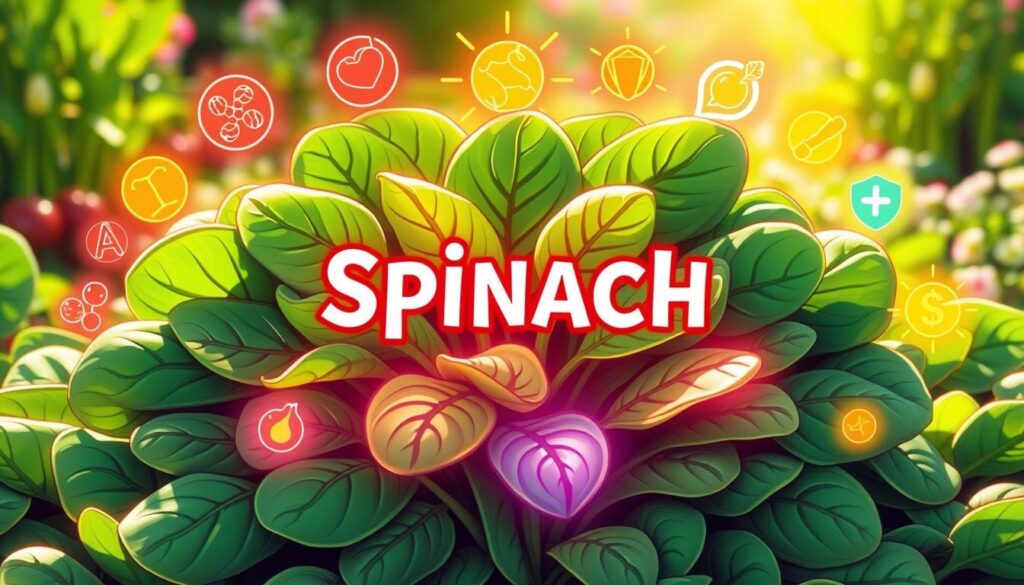
Vital Vitamins in Spinach
Our spinach leaves are full of nutrients that support health. The main vitamins in fresh spinach are:
- Vitamin A: Supports eye health
- Vitamin C: Boosts immune system
- Vitamin K: Promotes bone strength
- Folate: Essential for cell growth
Mineral Wealth of Fresh Spinach
Spinach is also rich in minerals. Important minerals include:
- Iron: Supports blood health
- Calcium: Strengthens bones
- Magnesium: Supports muscle function
- Potassium: Regulates blood pressure
“Spinach is nature’s multivitamin, with an incredible range of nutrients in every leaf.” – Nutrition Expert
Our spinach leaf quality indicators help us find the best time to harvest. By watching plant growth and knowing the best harvest time, we get the most nutrients. Fresh spinach is packed with nutrients, so timing is key for health-conscious gardeners.
Spinach Varieties and Their Harvest Times
Choosing the right spinach variety is key for a good harvest. Each type grows differently and has its own best time to pick. This can greatly affect your gardening success.
Knowing how spinach grows helps gardeners choose the best varieties. Each variety has its own traits that affect how and when to harvest.
Popular Spinach Varieties
- Bloomsdale Long Standing: Robust variety with crinkled leaves
- Baby’s Leaf: Perfect for container gardening
- Winter Bloomsdale: Frost-tolerant fall variety
- Space: Quick-growing hybrid type
Growth Patterns of Different Varieties
Our research shows interesting facts about harvesting spinach. Mature spinach plants grow about 25 full-sized leaves. Harvest times vary from 20-50 days, depending on the variety.
| Variety | Days to Harvest | Best Growing Season |
|---|---|---|
| Baby Spinach | 20-35 days | Spring/Fall |
| Mature Spinach | 45-50 days | Cool seasons |
| Microgreens | 7-14 days | Year-round |
“Knowing your spinach variety is the first step to a successful harvest.” – Garden Expert
Keep an eye on the temperature. Most spinach starts to bolt when it gets too hot, above 75°F. How often and how you harvest can help prevent this and keep your plants productive longer.
How to Extend the Spinach Harvest
Growing spinach doesn’t have to end after one harvest. With smart planting, we can keep enjoying fresh greens all season. Our guide shows you how to make your garden a spinach factory.
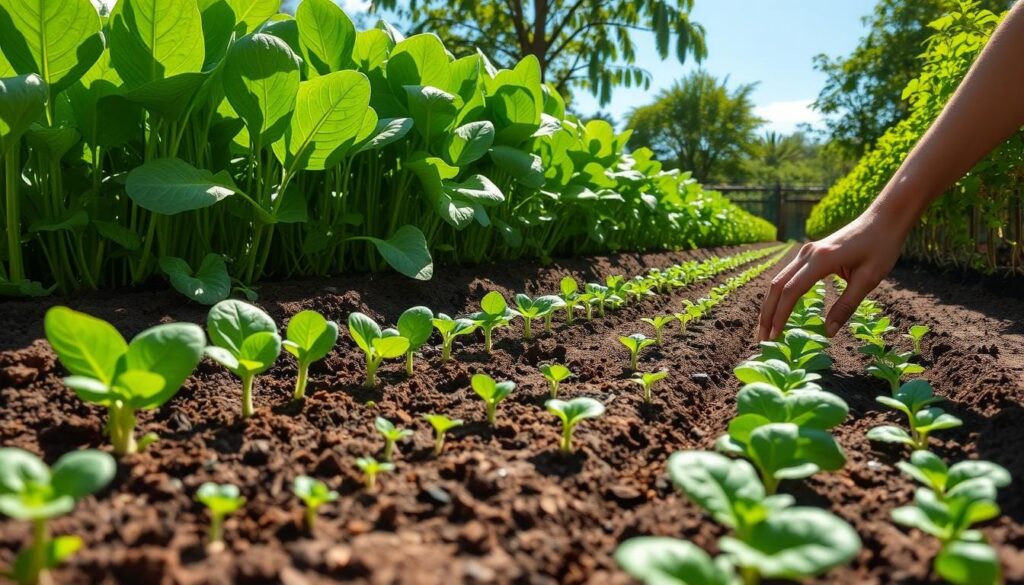
Successive Planting Strategies
Successive planting is a key to more spinach. By planting at the right times, you can keep your garden full of greens. Here are some tips:
- Plant new spinach rows every 2 weeks
- Start seeds in early spring and late summer
- Stagger plantings to maintain consistent production
Timing and Techniques
Our guide suggests ways to make your spinach harvest last longer:
- Seed spinach when soil temperatures reach 40°F
- Plant varieties with different maturation rates
- Harvest only 25-30% of leaves per plant
| Planting Period | Harvest Expectation | Days to Maturity |
|---|---|---|
| Early Spring | Baby Spinach | 30-40 days |
| Late Summer | Mature Leaves | 45-50 days |
| Early Fall | Cold-Hardy Varieties | 50-60 days |
Companion Planting Benefits
Companion planting boosts spinach growth and harvest. It helps manage pests, improves soil, and saves space.
“The secret to a bountiful spinach harvest lies in understanding your plants’ needs and creating an optimal growing environment.”
Incorporating Harvested Spinach into Our Diet
After picking spinach leaves from your garden, you’ll want to use them in your kitchen. Fresh spinach is versatile and nutritious. It’s great in many dishes.
Knowing how to prepare spinach depends on its quality. Raw, young spinach is perfect for salads and smoothies. More mature leaves are better cooked.
Delicious Recipe Ideas
- Fresh Spinach Salad with Vinaigrette
- Sautéed Spinach in Olive Oil
- Green Smoothie Blend
- Spinach and Feta Quiche
Storage Tips for Cooked Spinach
Storing cooked spinach right keeps its nutrients. Here’s how to do it:
- Refrigerate cooked spinach in airtight containers
- Consume within 3-4 days
- Cool completely before storing
| Spinach Type | Recommended Preparation | Storage Duration |
|---|---|---|
| Raw Baby Spinach | Salads, Smoothies | 5-7 days |
| Cooked Mature Spinach | Sautéed, Baked | 3-4 days |
“Spinach is not just a vegetable, it’s a nutritional powerhouse waiting to transform your meals.” – Nutrition Expert
Pro tip: Always wash spinach thoroughly before preparation to remove any dirt or contaminants.
Impact of Pests on Harvest Timing
Pests can greatly affect when to harvest spinach plants. They can mess up your growing season. Knowing when spinach is ready to harvest is key when pests are around.
Growing spinach needs careful pest control for the best harvest. Pests can harm plants at different stages. This can change when you can harvest your spinach.
Identifying Common Spinach Pests
- Cutworms: Attack young seedlings, causing significant early-stage damage
- Flea beetles: Create small holes resembling shotgun blasts on leaves
- Aphids: Cause leaf yellowing and stunted growth
- Leaf miners: Produce distinctive meandering trails on spinach leaves
- Wireworms: Damage roots and impact plant establishment
Preventative Pest Management Strategies
We have a detailed plan to fight pests:
- Use insect netting to protect against flea beetles and grasshoppers
- Implement crop rotation to disrupt pest life cycles
- Introduce beneficial insects like ladybugs to control aphid populations
- Apply organic solutions such as neem oil for targeted pest management
| Pest | Damage Type | Prevention Method |
|---|---|---|
| Aphids | Leaf yellowing | Ladybug introduction |
| Flea Beetles | Leaf holes | Reflective mulch |
| Wireworms | Root damage | Crop rotation |
Proactive pest management ensures healthier spinach plants and more predictable harvest times.
Early detection and intervention are key to protecting your spinach crop from destructive pest invasions.
Reviewing Our Harvesting Practices
Our journey in learning how to harvest spinach is ongoing. We keep track of our crops to get better at growing them. By noting planting dates, yields, and plant health, we gain insights into how to grow more spinach.
Reviewing our harvests is a detailed task. We keep a garden journal to record important info about each spinach crop. This journal includes notes on leaf quality, total harvest weight, and any challenges we face. It helps us see what works best for our garden.
Improving our methods is key to success. We look at our data to spot patterns and make smart choices for future crops. By tweaking our techniques, we aim for healthier plants and bigger harvests next year.
Evaluating Yield and Quality
We measure our spinach crop in both quantity and quality. We look at total harvest weight, leaf size, and plant health. By comparing these across seasons, we learn what makes spinach grow well.
Adjusting for Future Seasons
Every season teaches us something new. We use our data to tweak our planting, soil prep, and harvesting. This way, our spinach crop gets better and more resilient with each year.
